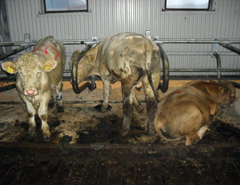Using same size cubicles for finishing bulls from weaning to slaughter by simple modifications of the design of the cubicles
There is a greater interest for using cubicles for the housing of growing-finishing young bulls. The function of the cubicles was investigated throughout the rearing period for young bulls of beef cattle from weaning to slaughter. The cubicles were dimensioned according to the final size of the animals. Manipulations of some details of the cubicles were made which controls the longitudinal space of the cubicle: position of the neck bar and introduction of a brisket board according to the length of animals and a combination of them. The cubicle width was kept constant during the experiment (1.12 m). Also, the impact of a plastic cubicle floor side separator (12 cm high, one meter long, placed between the stalls) was studied in a group of heifers on 2 occasions regarding cubicle hygiene. Cubicle hygiene, animal hygiene, lying behavior and how animals used the cubicles were recorded during three periods.
The problems of poor hygiene were greatest during the 1st period and then decreased. The combination of neck bar and brisket board placed according to the size of the animals resulted in better cubicle floor hygiene than only neck bar and brisket board plank separately. Animal hygiene improved during as animals became larger. In the beginning of the study, shortly after animals were weaned and housed, the animals lied in the cubicles about 1/4 of the time with the head (incorrectly) against the alley. This was later reduced, to completely have ceased at the end of the rearing period. The combination of neck bar and brisket board was most efficient in controlling hygiene but did not reduce the defecation in the front part of the cubicle. Cubicle floor side separators had no effect on flooring hygiene. There is potential for further development of cubicles for growing animals.
Conclusions
- Restrictions in the design of cubicles longitudinally (neck bar and brisket board) affects hygiene and cubicle management but will not prevent animals to turn around and defecate the front part of the cubicle
- Cubicle floor side separators did not prevent contamination of the lying area in cubicles, but the animals were positioned straighter in the cubicles.
- Development of the design of cubicles regarding hygiene should be focused on the younger animals and then tested on older and larger animals so animal welfare is not reduced
The project is funded by The Swedish Farmers' Foundation for Agricultural Research
Duration of the project: 2011-2013
Project Leader: Anders Herlin
Publications:
Herlin, A.H. 2012. Evaluating function of cubicles for cattle by a photometric method – description of a method. CIGR/AgEng July 8-12 2012 Valencia, Spain ISBN 978-84-615-9928-8
Herlin, A.H. 2013. Influence of neck bar placing and brisket board on hygiene in cubicles with weaned beef bull calves. XVIth International Congress on Animal Hygiene, ISAH 2013 Proceedings. Nanjing, China, May 5-9 2013, pp. 468-469.
Herlin, A. 2013. Samma liggbås under hela uppfödningsperioden (PPT). Alnarps Nötköttsdag, Nötköttsföretagande idag och i framtiden.3 december, Alnarp, s. 27-32
Herlin, A.H. 2013. Designing the lying area in cubicles for bulls. LEARN Newsletter, No 8, p. 3. November 2013 Faculty of veterinary medicine and animal science, Swedish University of Agricultural Sciences, Uppsala
Herlin, A.H. 2014. Growing young bulls in same size cubicles - measures to improve hygiene and welfare (Poster) Proc. Int. Conf. Ag. Eng., AgEng2014, 6.-10.07.2014, Zurich. Eur. Soc. Ag. Eng. (EurAgEng), 6 p. ISBN: 978-0-9930236-0-6
Links
